

 |
May 30, 2017: The Charles Bridge; Mala Strana; Old Town |
 |
Return to the Index for Our Visit to Prague |
Today is our last full day in Prague, and we will spend it, as we have other days, in castles, gardens and churches. It will be a full day, criss-crossing Prague again, and we will meet up with Jeffie after her work for our last dinner together in Prague.
|
To get to Vyšehrad Castle and grounds (and the Basilica, which is inside the original castle walls), we walked the block over to the I.P. Pavlova metro station and took the subway (which became elevated) south to the Vysehrad station. Then we walked about a quarter mile from the station to the Castle. After the castle and the basilica, we walked down to Rasinovo Street which runs along the Vltava, and there we caught a tram north. It curved with the street around the river, and we got off just before it crossed the Vltava heading north. We walked a quarter mile from there to St. Agnes.
After St. Anne's, we walked back to the "Cechuv most" (the Czech Bridge) and crossed the Vltava to the north. Then we walked west to the Malostranska tram/metro station and hopped on the same tram as the other day up towards Prague Castle. This time, we went another couple of stops beyond that castle, got off the tram, and walked about a half-mile south and up to the Loreto. After we toured the Loreto (and the gardens across the square), we returned to the tram back to Malostranska. There we descended to the Metro and took it back to I. P. Pavlova.
By this time we were getting pretty adept at negotiating the transit system and reading all the signs; Prague makes it pretty easy for visitors, and Jeffie's two minutes of explanation on our very first day stood us in good stead throughout our stay here.
Vyšehrad Castle and Grounds
Although I have already referred to Vyšehrad as a castle, it is actually more of a fort. Prague Castle was too, but it took the appellation of a "castle" probably because the nominal rules of this area of Bohemia took up residence there. No rules resided at Vyšehrad, although it was a major installation.
Getting to Vyšehrad
|
A couple of block later we came out right at the entrance to Vyšehrad park. At first, we thought that this was actually the entrance to the fort, for it looked as if the archway led through what would have been the fort's wall, but, as it turned out, this was really an entrance to the park area, not the fort itself.
The entrance to the park area was unassuming, but then this wasn't actually the entrance to the fort itself; that was through the Leopold Gate a ways down the street past some shops and a cafe or two. Entrance to the park is free, of course, but so is entrance to the fort. The only admission we paid while at Vyšehrad was actually the nominal fee to tour the Saint Peter and Paul Basilica.
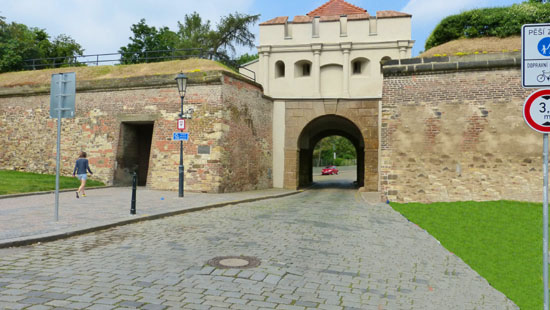 |
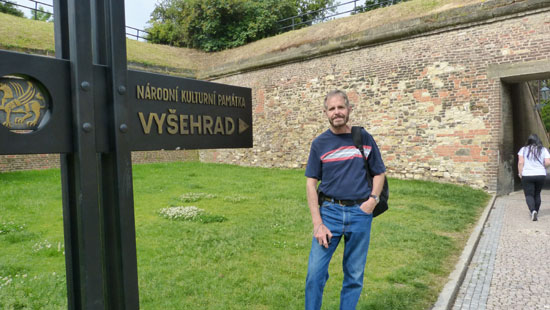 |
Just inside the archway, we discovered from the diagram of Vyšehrad that we had just come through the Tabor Gate; the actual gate to the fort is the Leopold Gate which is about an eighth of a mile down the cobblestone street from the first gate we went through. In case you'd like to peruse that informational sign, which pointed out all the features of the park and the fort, I have put a picture of it in the scrollable window below. If you want to find the Tabor Gate through which we entered, it's #1 in the lower right corner of the image.
We did walk down the street to the actual fort entrance at the Leopold Gate. At that gate, the ground dropped away and we crossed a bridge to get through the gate. I assume there was a moat here at one time. Inexplicably, there was also a tennis court on the other side of the bridge, nestled up against a corner of the fort's wall.
Vyšehrad: History and Layout
|
Local legend holds that Vyšehrad was the location of the first settlement which later became Prague, though thus far this claim remains unsubstantiated. As you can see at left, most of the original walls still exist; I have outlined them in yellow, as they are hard to see in spots. (I have also marked the location of some of the things we'll see here in Vyšehrad.) In addition to those marked features, we almost circumnavigated the fort, walking around most of the wall; there are walkways around the interior of the wall- except for the section above the river.
When the Premyslid dynasty settled on the current site of Prague Castle, it and Vyšehrad maintained opposing spheres of influence for approximately two centuries. This second seat of the Czech sovereigns was established on a steep rock directly above the right bank of the Vltava river, in the 10th century. The zenith of Vyšehrad was during the second half of the 11th century, when Vratislav transferred his seat from Prague Castle, and the original fort was remodelled as a complex comprising a sovereign's palatial residence, church and seat of the chapter. The period of growth ended around 1140 when Prince Sobeslav moved his seat back to Prague Castle.
When Holy Roman Emperor Charles IV began to build the Prague Castle to its current dimensions in the early 14th century, the deteriorating castle Vyšehrad was abandoned as a royal home. Later the whole complex was renewed by Charles IV and new fortifications, with two gates and a royal palace were built, while the Basilica of Saints Peter and Paul awaited repair.
|
The present form of Vyšehrad as a fortified residence, with powerful brick ramparts, bastions, the Tábor Gate and the Leopold Gate, is a result of Baroque remodelling. The Cihelná brána (Brick gate) is an Empire-style structure, dating from 1841. The main part of the Spicka Gate, parts of the Romanesque bridge, and the ruined Gothic lookout tower known as Libusina lázen (Libuse's Bath) are the only fragments that have been preserved from the Middle Ages.
The Romanesque rotunda of St. Martin dates from the second half of the 11th century. The 11th century Church of Sts. Peter and Paul, which dominates Vyšehrad, was remodelled in the second half of the 14th century and again in 1885 and 1887 in the Neo-gothic style.
Vyšehrad and the area around it became part of the capital city in 1883. The area is one of the cadastral districts of the city. Today, Vyšehrad is a public park that is a popular site for recreation and celebrations. For example, it is a popular place for Czechs to celebrate New Year's Eve. So let's go wander around the fort and the Basilica and see what we can see.
The Rotunda of St. Martin
|
Walking Along Vyšehrad's Northern Walls
 |
In Fred's two pictures below, both looking northeast, you can see other city walls, not part of the Vyšehrad fort complex. In the left-hand picture, you can see these walls snaking up the hill (you can tell it's a hill because you can't see the bottom of the Zizkov TV Tower) opposite, and in the closer view on the right you can see that there are people atop them:
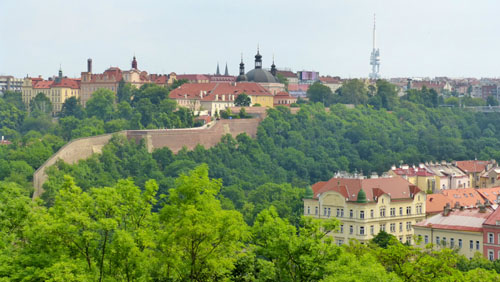 |
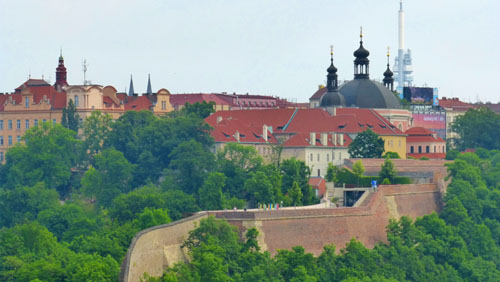 |
I took a couple of pictures but from a different angle. The picture at right (below) looks more southeast along the fort wall; the large white building you can see is the one we walked along from the metro stop earlier; the metro line runs between that building and the taller one further away. The other picture shows you how that other city wall runs down across the valley; I believe that it connects to the fort's wall somewhere down below.
|
|
We came around that northeastern point in the fort's walls and found ourselves, of course, on the portion of the wall that faces generally north. As you can see from the aerial view above, the walls aren't just straight, but have corners that would have allowed defenders to see down to the base of the walls from just about every angle. From one of these corners, you can see clearly the steep, 60-foot-high walls; there seemed to be some repair work going on. The houses and other buildings of today's Prague come right up to the base of those walls.
We took lots of interesting pictures from these north walls; eleven of them are in the slideshow below, left. As usual, move through the show using the little arrows in the lower corners of each image. At the right of the slideshow, and continuing below it, are some comments on some of the pictures.
|
|
3/11: A tableau showing points of interest
5/11: The Prague (Brick) Gate
6/11: Church of the Assumption of the Virgin Mary
7/11: The north wall
8/11: Prague Castle in the distance
11/11: Below the northwest corner of the Vyšehrad wall
In this picture of Fred on the north wall, you can see some of those angular turns in the fortification; the view actually looks southwest into Vyšehrad, and we got our first views of the spires of the Basilica of Saints Peter and Paul. Before we leave the wall and head south into the interior of Vyšehrad, I have a couple of panoramic views to show you. The first one my camera created, and it was taken from the northeast corner of the wall:
 |
And this one, taken from the middle of the long north wall (right above the Prague Gate) was put together from five separate images:
 |
Sculpture Gardens at Vyšehrad
|
|
It remained there, the focal point for all kinds of gatherings- particularly Masses. One was held, for example, during a plague epidemic in 1713 at a time church gatherings were prohibited. In 1827, it was moved to a classicist pedestal and placed in front of a then residence on the site of today's Hotel Europe, at the top the square. At that location, it was the focal point of a Mass held in 1848- the first Prague event portrayed daguerrotypically, and the beginning of the Prague June Uprising. In connection with this event and the sculpture, the square was renamed to Wenceslas.
For reasons I cannot discover, in 1879 the statue was placed temporarily in a municipal warehouse and then moved to its current site here at Vyšehrad chapter. In 1913, a larger Wenceslas statue, created by Josef Václav Myslbek was placed in Wenceslas Square. The statue we saw here is not the original Bendl work; 1959 sculptor Jirí Novák created a copy, a copy that remained in his possession until the end of the Velvet Revolution. In 1990, that copy was placed here and the original was moved into the National Museum.
|
His first parish was in Kvílice; he stayed there for four years until his health caused him to apply for a transfer to Prague, where he served as the priest at an institute for the blind and later at the church of St. Catherine. In addition to serving as a priest, he also devoted himself to literary work. Thanks to his college contacts, he became a member of political and literary elite. He studied the Polish language, and became a "polonist". He wrote poetry and contributed to various Czech periodicals, later founding a Czech Catholic magazine, which gradually spread throughout the Habsburg empire.
It is not surprising that he was drawn into the events of 1848. He was a member of the National Committee and an organizer and leader of the Slavonic Congress. From 1849 to 1860 he was a professor of religion at the Academic Gymnasium in Prague. he led the movement to celebrate the Slavic scholars Cyril and Methodius, and became a priest here at Vyšehrad.
He was devoted to elevating the importance of Prague, and particularly that of Vyšehrad- both the fort and the area around it. He brought new priests to the area and influenced the construction of new churches. Balancing his duties as a priest with his devotion to the province around Vyšehrad, he eventually was installed as the leader of the wider community. His work to rehabilitate and expand Vyšehrad made the fort and the area around it a beautiful and desirable area of Prague. It was his idea to extend the original Vyšehrad parish cemetery around the Chapel of St. Peter and Paul and to create a Czech national burial ground with a monumental tomb of giants of the Czech nation. (It was he to had the Statue of Wenceslas transferred here.) He was also the leader of the effort to transform the Baroque chapel into the Basilica it is today. He lived to see the new church consecrated by Bohemia's highest ecclesiastical and secular dignitaries before his death in 1887. His tomb in the cemetery here is one of the largest and most-visited. Václav Štulc is rightly called the founder of modern Vyšehrad.
On the south side of the Basilica, there are four monumental statues by Josef Myslbek depicting haracters from early Czech mythology; these were all made between 1889-1897, and are now situated on a sculpture lawn.
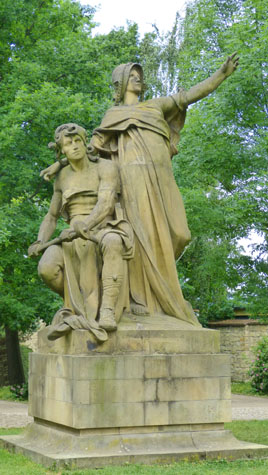 Libuše and Premysl |
(Picture at left) According to legend, Libuše, daughter of King Krok, had a dream in which her horse led her to her future consort. Libuše rode into the hills and came across a ploughman named Premysl. He was taken back to Vyšehrad and became the father of the great Premyslid dynasty. In another dream, the horse took Libuše towards the area where Prague Castle now stands. "Go until you reach a man making a lintel for his house", the vision had said, "and on that spot you will found a city whose fame will reach the stars." She did, and named it "Prah", the old Czech word for a lintel. The sweeping gesture of the arm in this statue refers to that defining moment in Bohemian history.
|
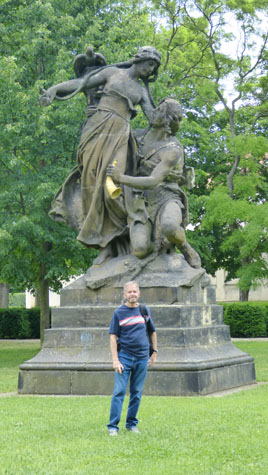 Ctirad and Šárka |
All four statues were originally at either end of one of Prague's bridge, and suffered some damage during WWII. One of the groups was actually damaged beyond repair, and what we saw here this morning is a copy. Can you tell which it is?
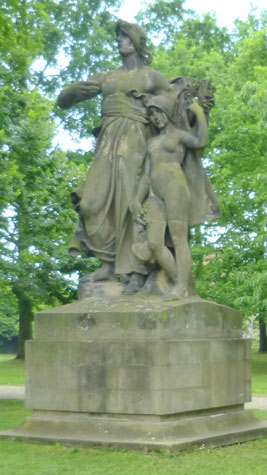 Lumír and Písen |
(Picture at left) Originally on the Palacký Bridge and damaged in the bombing in 1945, this statue was brought here. It depicts the legendary bard Lumír and Písen ("song"). According to Königinhofer handschrift Lumír refused to sing a hymn for the winners of The Maidens' War, and sang instead his last song to the Vyšehrad, then breaks his instrument and never singing again. Albeit lacking authenticity, the story was considered a symbol of national conscience in the 19th century.
(Picture at right)
|
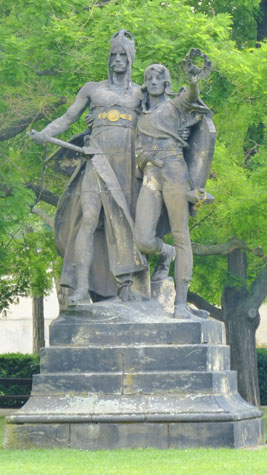 Záboj and Slavoj |
Incidentally, the statue of Libuše and Premysl is the copy. There were other, more eclectic sculptures around this area of the fort; here are a few of them:
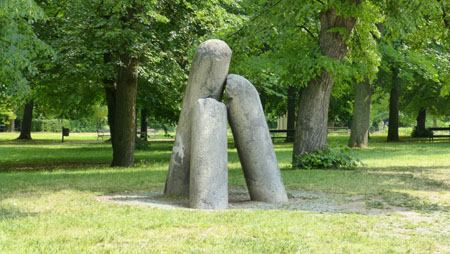 |
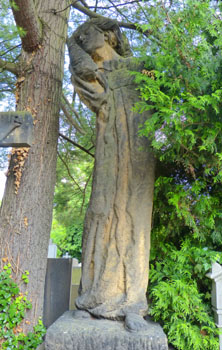 |
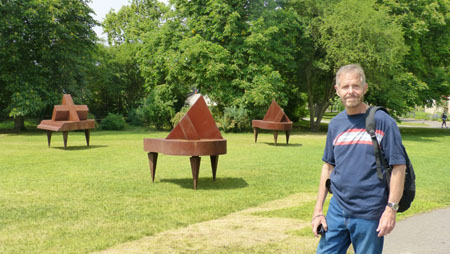 |
Along the Southern Ramparts of Vyšehrad
|
A little distance further and the walk sloped up to come out on the paved path that led along the inside top of the fort walls, and from here we could get really nice views of the Vltava flowing up from the south. Again in this picture, you can see how high the walls of Vyšehrad actually were- particularly along the river. You can also see the the development of the area around Vyšehrad has brought buildings right up to the steep walls.
There were good views from here; this was as far south as we came in Prague, and Fred was able to get a closeup view of the interesting downtown buildings that we had seen from much further away at places like the St. Vitus Bell Tower, the Petrin Tower, and the Zizkov TV Tower. Of particular interest were the two buildings that seem to both be leaning outward.
|
I marked the pathway up to the rampart from the sculpture lawn where the four large mythic sculptures were. Some of the other sculptures we saw were actually in a grassy area at the southeast corner of the fort. We took many of our pictures from the inset area between the two protruding sections of the fort; remember that those protrusions were undoubtedly to allow defenders and guards atop the wall to have a clear field of view along the bottom of those same walls; were the walls totally straight, this would not have been possible.
You might recall having seen this classic "fort" shape before; forts like Ticonderoga in New York State, Sumter in South Carolina, and Fort St. Augustine in Florida all have similar shapes. Here are some of the pictures we took along this southern wall as we walked from the spot where we came up onto it over to the Leopold Gate:
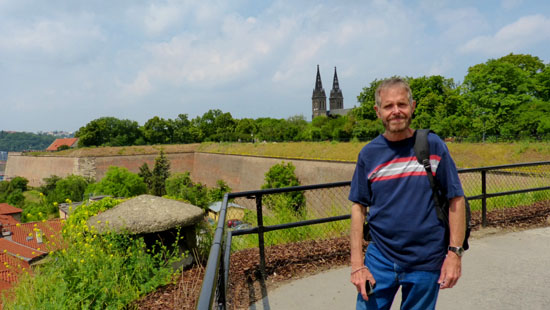 |
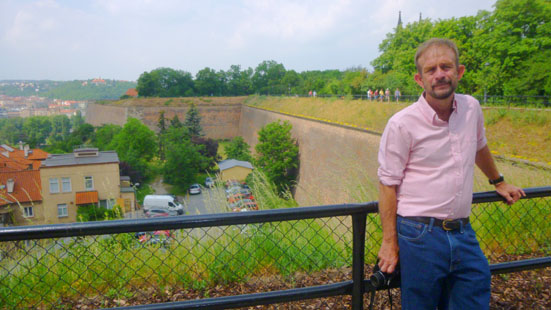 |
|
|
I tried my hand at letting the camera take a panoramic picture for me. It took a couple of tries (you have to move the camera and just the right, constant speed), but I got a pretty good result:
 |
We walked east along the wall, coming around the southeast point to where we could see the Leopold Gate from above. When we came through the gate earlier, we headed northeast up to the wall, but apparently we could have come up this this walkway to begin our tour of the fort here, on the southern wall. We came down off the wall and cut back through the park to the west, passing once again the row of rooms that had the climbing roses on their outside wall. Going by, we thought they were actually for storage.
We went by the statues again and up another little walk to come out on the southwest parapet at that corner of the fort's walls. From this point, we could see more of the Vltava River, and there were some good opportunities for panoramic photos looking to the southwest:
 |
We could look down below us, between the fort's wall and the river, and note that the street that runs along the river narrows and goes through a tunnel, as the rock outcrop on which the fort is built comes right down to the water here. At this point, the fort's wall is basically going north, paralleling the river, so we got excellent views looking north along the Vltava.
|
 (Click on Thumbnails to View) |
The west wall along the river brought us, essentially, to a tour of all sides of the wall, and we also had a chance to see much of the park that now exists inside the walls. Now that we're done with the fort area itself, we can have a look at the Basilica of Saints Peter and Paul and the historic cemetery alongside it.
The Collegiate Church of Saint Peter and Saint Paul
The largest structure still existing here at Vyšehrad is the Church of Saint Peter and Saint Paul. The church, along with its adjacent cemetery, was the highlight of our visit to Vyšehrad- although wandering around the fort's walls and through the park that now exists within those walls was very enjoyable.
A Bit About Cathedrals, Basilicas, and Churches
|
Catholics tend to use two other terms we should be aware of. First of all, a "cathedral" is a church which is also the "seat," in the bureaucratic sense more than the literal sense, of a bishop (or, in some denominations, another comparably high-ranking ecclesiastical figure). While a city may have many churches, you therefore ordinarily see no more than one cathedral per denomination per city, and of course small cities may not have their own bishop and so would not have a cathedral at all- just churches. Because bishops are responsible for an area (in Catholicism a "diocese"), a cathedral can also be thought of as the church associated with the administration of an area. In common usage, people call really big churches cathedrals pretty often, but this is imprecise and technically mistaken.
A "collegiate church" (like the one here at Vyšehrad) is a church where the daily office of worship is maintained by a college of canons; a non-monastic or "secular" community of clergy, organised as a self-governing corporate body, which may be presided over by a dean or provost. In its governance and religious observance a collegiate church is similar to a cathedral, although a collegiate church is not the seat of a bishop and has no diocesan responsibilities. Collegiate churches were often supported by extensive lands held by the church, or by tithe income. They commonly provide distinct spaces for congregational worship and for the choir offices of their clerical community.
|
| The papal or major basilicas outrank in precedence all other churches. Other rankings put the cathedral (or co-cathedral) of a bishop ahead of all other churches in the same diocese, even if they have the title of minor basilica. If the cathedral is that of a suffragan diocese, it yields precedence to the cathedral of the metropolitansee. The cathedral of a primate is considered to rank higher than that of other metropolitan(s) in his circonscription (usually a present or historical state). Other classifications of churches include collegiate churches, which may or may not also be minor basilicas. |
I don't know if you find that a bit confusing; I certainly do.
So what is this church here at Vyšehrad actually called? Well, it seems to be one of those churches that has two different appellations. First of all, on the facade of the church there is a carved stone plaque identifying this church as the "basilica S. Apostolorum Petri et Pauli"- the Basilica of the Saint Apostles Peter and Paul. (To confuse the issue a bit further there is another carved plaque on the other side of the facade that identifies the church as a " Basilica Minor". Now that we know what "basilica" means, we can simply refer to this as a church (but not a cathedral, since no bishop is headquartered here); it is just built in the style of a basilica.
Apparently, this church is a collegiate church; at least that is what the heading was on the little laminated brochure that we borrowed at the entrance, carried with us through the church, and returned when we left. The heading was "The Collegiate Church of Saint Peter and Saint Paul". I know I have called it a basilica in some places and a church in others; indeed, it is both. Although it is actually a collegiate church, I will continue to just call it a church or a basilica. But I won't call it a cathedral, because that is the one thing it is definitely not.
(I might also point out that in investigating its history, I have seen both "...of Saint Peter and Saint Paul" and "...Saints Peter and Paul". I don't know that either is the preferred method of reference when a church is dedicated to more than one saint or Biblical figure.)
The Outside of the Church of Saints Peter and Paul
|
This basilica is a bit unusual in that there is no transept. Structurally, the building is quite vertical, its ceiling is cross vaulted and the pointed arched windows let in the sun’s light through stained glass. A few meters east of where the church now stands beyond the cemetery walls the original foundations from the apse of the old Gothic church were excavated. To take the picture at left, I am standing at approximately that spot. The old apse and the new apse are designed in the same fashion; they are both buttressed and have the same number of buttresses.
The western façade (see the picture above, right) features three vestibules, two towers, and a crowning triangular gable between the towers. The main portal tympanum is decorated by Jesus standing with his apostles. Below them the archangel Michael stands between people being ushered to heaven by angels, and people crippled by the suffering of sin. On the gable face stand sculptures of the basilica’s namesake saints Peter and Paul with angels and Jesus.
Another interesting feature of the Saints Paul and Peter’s Basilica design is the spires, which are hollow. They have slender holes making the tops of the towers light and elegant reminiscent of the conic formation of the chestnut flowers one can find blooming in trees along the walkways in the Vyšehrad complex. The spires (and indeed the triangular gable of the façade between them) are frilled with pedal like finial protrusions along their length and on their tops, further connecting their likeness to the flower.
|
I made a movie looking up and down the facade of the church, and you can use the movie player below to watch it:
|
(Mouseover Image Above for Video Controls) |
Fred, as usual, had an eye for the detail of the facade of the basilica, and he took a number of interesting close-up pictures of elements of that facade:
 (Click on Thumbnails to View) |
Inside the Basilica of Saints Peter and Paul
|
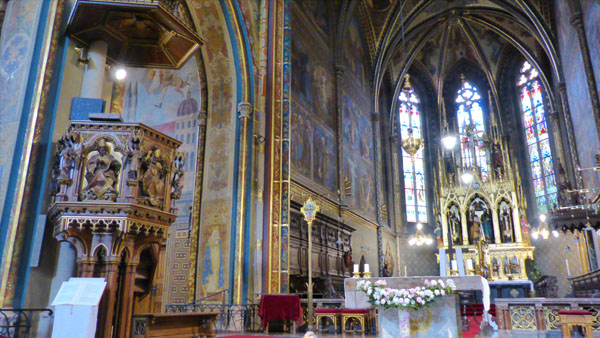
Even the organ which sits above the entrance has hollow spires matching those of the western towers.
|
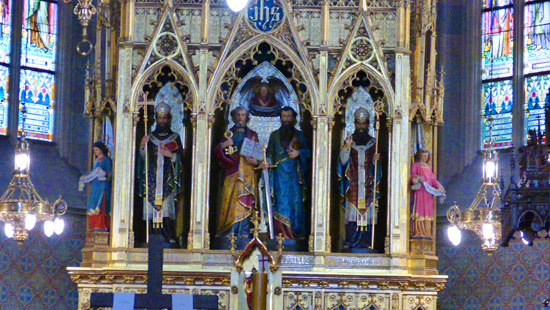
The theme of the stained glass windows is the history of Gothic architecture; each window portrays Jesus before a different Gothic or neo-Gothic church. Below are two short slide shows. The one at left has six of the best pictures we took of the stained glass windows in the side chapels; the one at right has four good closeups that Fred took of these and other stained glass windows in the basilica:
It seemed as if every surface was covered with frescoes of one kind or another- including one of the first Gothic church to stand on this spot (which we would have photographed but it was high up and the light at the end of the northern aisle was dim).
|
It seemed as if there were perhaps ten or twelve of them altogether, although we photographed only the five that you can see at right.
From the explanatory document we carried around with us, we learned that they were all done by the painter František Urban and his wife Marie Urbanová-Zahradnickáthe over the space of years.
As with most cathedrals constructed on the basilica plan, there were numerous side chapels on either side of the northern and southern aisles. It was in these chapels that most of the stained glass was found. Each chapel had an altar of some kind, and each contained one or more Gothic revival paintings. Here are some of those chapels:
 |
Also, in each chapel are large baroque paintings from the 16th century, maintaining the link to another part of the church’s past. There is a large fresco at the eastern end of the northern aisle of the first Gothic church to stand on the spot. The last building to be on the spot was a baroque church built in the first quarter of the 18th century. It had no towers, but the façade was quite decorative including a great number of ionic pillars.
What we found really interesting here in this particular church was the fact that seemingly every square inch of the walls, pillars and arched ceilings was covered in ornate, flowing decoration. Here are a couple of examples:
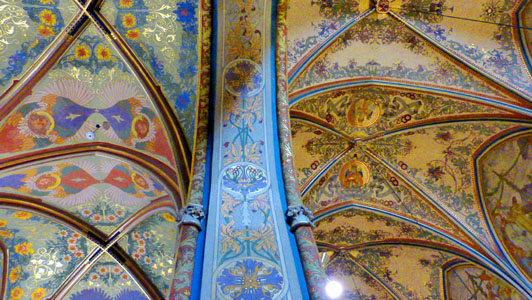 |
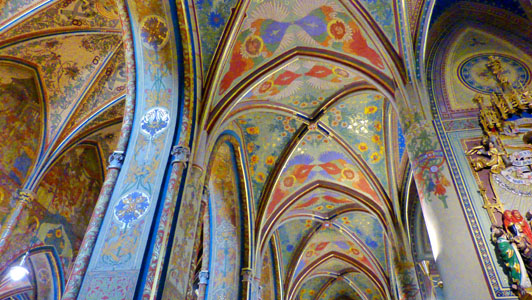 |
This decoration is also the work of painter František Urban. Nameless winged women flank the archways from the nave and fill the vault sections of the arcades. Up the pillars and along every picture’s border run floral patterns and colourful ribbons. The vivid greens and browns which cover the entirety of the interior create a feeling of being inside a forest. The ceiling of the nave is dark green, as if it is a canopy in shadow. Even the brown wooden benches on the ground for the beholders of church services are ornately carved with oak leaves. It was difficult to choose just a few of the many pictures we took of this ornate decoration; here are some more of the best of them:
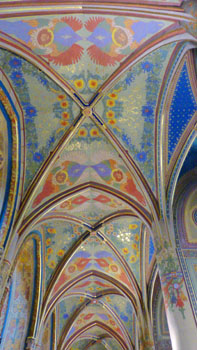 |
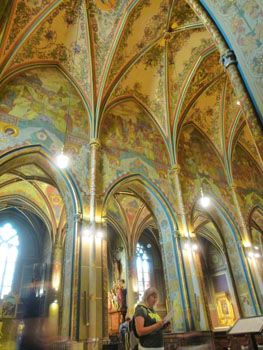 |
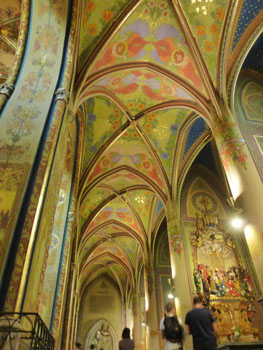 |
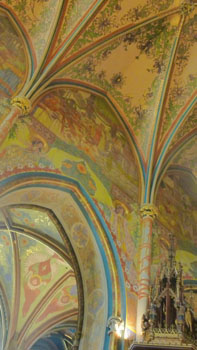 |
In one corner of the front of the nave there was what seemed to be a small museum- a display of religious objects, many of which were very, very beautiful (as have hundreds of such objects we have seen in churches around the world), reminding me once again of how much effort and expense has gone into houses of worship over the century. Here are some final pictures from inside the basilica; you'll see more of the religious objects and a pair of photos of either side of the main altar:
|
|
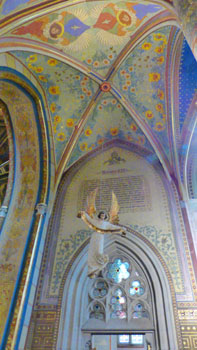 |
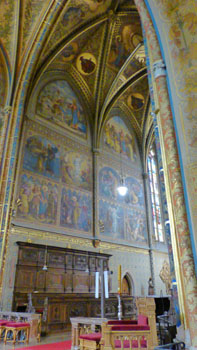 |
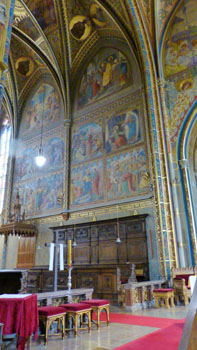 |
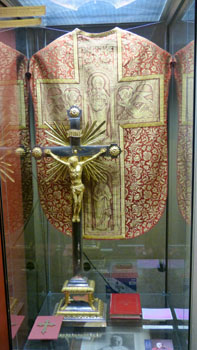 |
The Basilica of Saints Peter and Paul was certainly beautiful; as I said above, the standout feature here seemed to be the fact that the walls and pillars were absolutely covered in frescoes and paintings. When we left the church, we walked outside to the north and east sides of the structure to look at the extensive and historic cemetery.
The Cemetery at Vyšehrad's Basilica of Saints Peter and Paul
Established in 1869 on the grounds of Vyšehrad Castle, the Vyšehrad cemetery is the final resting place of many composers, artists, sculptors, writers, and those from the world of science and politics. The centerpiece of the cemetery is the Slavín tomb designed by Antonín Wiehl.
|
We actually entered the cemetery from the south (before we visited the Basilica), and there, I took a picture of
the interesting scrollwork
above the entrance. Perhaps the keys are significant- maybe "keys to the kingdom" or something like that. We walked through that entrance, and I asked Fred to stop for a moment so I could get a picture
looking north out of the cemetery.
When I looked ahead into the cemetery, I also thought that the cemetery had placed perhaps the most elaborate indication of what is allowed and not allowed in the area that I have yet seen; you can have a look at it
here. The north wall of the cemetery is actually a row of covered tombs and memorial that stretch away from you on either side. You can see what these galleries looked like in the pictures at left and right. We'll look more closely at some of the tombs in these arcades in a minute. Fred also took some pictures of these galleries, and you can see some of them below:
|
|
Coming through the entrance in the south wall, we were in the cemetery proper which consisted of two areas with a walkway leading to the Basilica dividing the two portions.
|
The larger portion of the cemetery, also partially bounded by crypt galleries, extended eastward and wrapped around the rear of the church. Along the east wall was the Slavin, which we will talk about in a little while. It seemed as if the graves in this area of the cemetery were not only older, but more ornate.
As we had done at the Bone Church a few days ago and at the Jewish cemetery near the Zizkov TV Tower, we spent some time just wandering up and down the pathways looking at the huge variety of different graves, memorials and monument, photographing quite a few of them.
|
|
At the far east end of the cemetery is a special memorial- the Slavín tomb. Construction of the tomb was the result of a idea for the establishment of a pantheon, a joint last resting place of outstanding Czech personalities. The idea first appeared in the 1880s, and the initiators were Vyšehrad provost Mikuláš Karlach and Smíchov Mayor Petr Matej Fischer, who also helped to finance the monument.
|
|
You can see that on the altar in the middle of the steps there is an inscription. The Czech reads: "Kdo ve mne verí nezemre na veky" which translates directly to "Whoever does not die in me forever", which I take to mean "Whoever is in this monument will never die".
Our tour of the cemetery here at the Basilica brought our visit to Vyšehrad to an end. Our next stop would be the Convent of St. Agnes and its garden, which would require traveling to the other side of town.
The St. Agnes Convent and Garden
The convent of Saint Agnes is situated on the right bank of Vltava, in the Prague Old Town area called "Na Františku“. The monastery of Poor Clares of the Order of Saint Clare and Franciscans was founded in 1231 by Agnes of Bohemia, who also became the abbess of the convent. The convent is supposed to have a sculpture garden and museum; the church itself is old but the museum is fairly new.
|
This brought us to the tram stop for the #17 tram. We hopped on the next one that came by; it took us all the way north and around the bend in the Vltava River. Our destination was this side of the river, so we got off the tram just before it turned to cross the Cechuv Bridge across the river. This happened to be right in front of the Intercontinental Hotel.
To get to St. Agnes, we had to walk about three blocks east on Dvorakovo Street, which is right beside the river, so we had nice views as we went.
It was neat walking along the river; there is always boat traffic, and we seemed to be in an area were some of the cruise boats that ply the river dock.
|
Here are just a few of the pictures we took between where we got off the tram and St. Agnes:
 (Click on Thumbnails to View) |
About halfway down to St. Agnes, which is just south of this street along the river, I stopped to see if my camera would take a panoramic picture for me. I have learned on panoramic shots that if there is something close to you in the panorama, it is going to be distorted, as the Vltava River is in this picture:

About a third of a mile east along the river, we could see St. Agnes across the road, so we headed over. We found ourselves at the entrance to the museum portion of the complex. Agnes of Bohemia was the youngest daughter of King Ottokar I of Bohemia and was herself raised in a convent- an obvious influence on her later decision to become a nun. She was for a time engaged to Henry VII of Germany, the son of the German emperor, and lived in a convent in Klosterneuburg, but when their engagement was cancelled Agnes moved back to Prague. Her father then arranged a marriage offer from Frederick II, Holy Roman Emperor, but when Agnes' father died, she used her newly gained freedom of choice and decided to establish a convent- a decision in which she was supported by the Pope and her family.
|
South of us, at the end of a walkway, was the new museum and cafe, along with an outdoor area where one could sit and relax; it was here that we decided to eat the lunch that we'd bought this morning at the little cafe across the street from the hotel. We didn't go into the museum, but instead left this area by the entrance we'd come in and then walked around the north side of the convent buildings to the larger sculpture garden on the east side of the complex, just north of one of the original chapels- the Church of St. Salvator.
I think it is interesting that on the aerial view, the large sculpture garden was still under construction; it was completed when we were there, and we saw no signs of its construction, so I assume it was completed some time ago. Anyway, that's how the Convent and Churches at St. Agnes are arranged, so you can place where we were when we took many of our pictures. While we were standing in that courtyard, I wanted to try a 360°-view of that area. I couldn't get my camera to do it (trying to maintain constant speed and level during a full turn is very difficult), so I took eleven pictures and tried to put them together. In long panoramas, lighting changes are a problem, and cause abrupt changes when you stitch pictures together. There are a number of those transitions in the panorama below, although I've tried to smooth some of them out. With the entrance we came through at the left of the picture, here is that panorama:

We had actually thought when we put St. Agnes on our itinerary that it had actual gardens; that's what intrigued Fred. We did not realize that it was actually a sculpture garden, but we were happy to have visited anyway. The exact year when the convent was founded is not known, but it was presumably in 1231, after the negotiations about Agnes' marriage were completed. Agnes' brother, king Wenceslaus I of Bohemia, donated the ground on the bank of Vltava river, which was very convenient for a hospital. Simultaneously, Wenceslaus licensed the convent with many privileges. One of the oldest parts of the convent of St. Agnes was the main sacred area, the church of St. Francis, which was built without a presbytery at first. Along with the church, a spacious east wing of the convent was built. The convent was consecrated in 1237.
|
Having read some of this history at the museum, we decided to head over to the east side of the complex to look at these chapels (as there was no direct way through the museum). We took some additional pictures as we were walking back to the entrance, including the picture at right. Here are some of the others:
 (Click on Thumbnails to View) |
We walked back out the entrance and along to the east to the sculpture garden. It was bounded by the convent wall on the north, the Czech Ministry of Industry and Trade on the east, the Church of St. Salvator on the south and one of the convent buildings on the west. There was a raised area where most of the sculptures were located, although some were on a lower level next to St. Salvator.
|
We both thought that the Ministry building was very ornate for a government facility, but then most buildings in Prague are quite old and have often been repurposed multiple times. As it turns out, though, this impressive ministry building is not one of those repurposed structures. It was actually designed as a government building by architect Josef Fanta and was finished in 1934 with a record-high budget.
|
The Church of St. Salvator was built to contain the mausoleum of the Premyslid dynasty; its architectural quality is higher than in other parts of the convent. After learning something of what the inside is like, we perhaps should have gone inside (if that was even possible). A nave with two bays of groin vault and a pentagonal end was done by an unknown French master; it is connected with the chapel of Virgin Mary by a triumphal arch, which was built after the church was finished.
We concluded our visit to St. Agnes by wandering around both levels of the sculpture garden, looking at each of the installations. Here are the best of the pictures we took in this area of the convent:
 (Click on Thumbnails to View) |
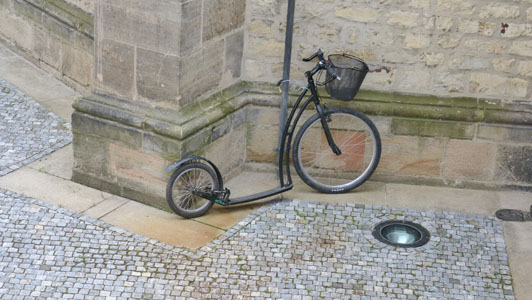 |
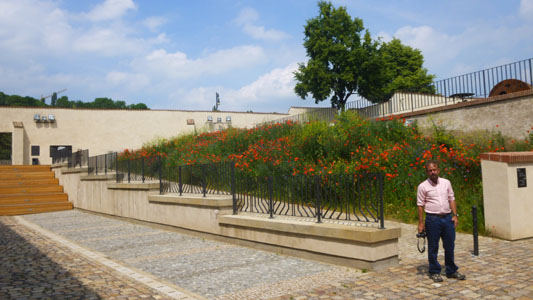 |
St. Agnes Convent and the two churches was an interesting stop, although we missed what we thought might be some nice gardens. We left via the walkway by the Church of St. Salvator and then walked back north to the Vltava, and then turned west. We are heading now back to the district near Prague Castle to visit the Loreto- a cloister and church.
|
There, we'll hop on the same tram that goes to Prague Castle, except that we'll go a couple of stops further. When we get off, we'll walk a few blocks south and through a typical Hradcany neighborhood to the Loreto.
We retraced our path along the south bank of the Vltava River, passing once again all the swans that folks were still feeding and a number of the excursion boats that were preparing for their afternoon river cruises, until we reached the Cech Bridge.
|
The bridge, seen at right from the north side of the river, connects the Prague district of Holešovice with the Old Town (Staré Mesto). The bridge is made of iron (used in the arches) and stone (used for the pillars). One unusual aspect of the bridge was that up until 1961 the roadway was actually made of wood– a hard species named "Jarrah" from Australia. The roadway got very slippery during rains.
Designed by Jan Koula and Jirí Soukup, the bridge is Art Nouveau in style; sculptures (including four put in two pairs on 50-foot-high pylons at either end of the bridge) adorn the structure. The bridge was named after recently died Czech writer Svatopluk Cech (1846–1908). During the German occupation the bridge was called the Mendel Bridge, after the German Gregor Mendel (of German ethnicity). The bridge has undergone numerous reconstructions and repairs- the most extensive in the early 1970s. In the mid-1980s the sculptures were cleaned and repaired. As the only Art Nouveau style bridge in the Czech Republic, it is protected by state. It is used by tramways, cars and pedestrians. We took a number of pictures of the sculptures and adornments, and you can see some of them below:
 (Click on Thumbnails to View) |
While on the bridge, I let my little camera do a panorama looking south back towards the Old Town:
 |
Walking along the north side of the river (there was a small street right on the bank) we had a really pretty view to the south, and we were quite close to the river all the way to Malostranska. In Fred's picture, you can see the vineyards that I mentioned when we toured Prague Castle the other day, and you can see the tram stop where we will be hopping on.
|
|
"Operation Anthropoid was the most successful collective effort of the Czechoslovak home and foreign resistance. Assassination of the high-class Nazi NSDAP member; top member of the SS organisation and Nazi police in 1942; when Nazi armies occupied almost all of Europe came in as a shock for the German Third Reich. It is very difficult to find a similar action of such significance in other German-occupied areas. The atrocious Nazi machinery lost one of its chief brutal minds, which could hardly be replaced.
The operation costed many victims, not only in ranks of trained soldiers- paratroopers, but also among supporters of the home resistance, and innocent people who fell target to the brutal Nazi revenge. We dedicate this exhibition to all brave men and women, who fought in the Second World War and to all war victims. Honor to their memory."
|
I took a few pictures of Fred as we walked up the street to the Loreto, and one as we returning a couple of hours later. You should be able to place at least one of them on the aerial view (hint: it looks north towards a fork in the street).
 |
As you probably know, I am always spotting mistakes in signage all around the world- even in countries where English is the spoken and written language. Prague was no exception, although they get a pass because they go to the effort of even providing English for us tourists in the first place.
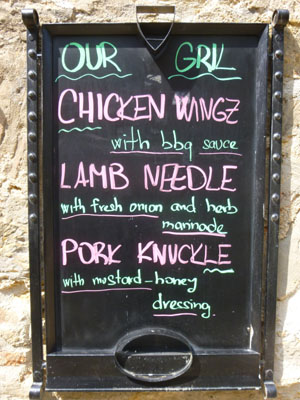 |
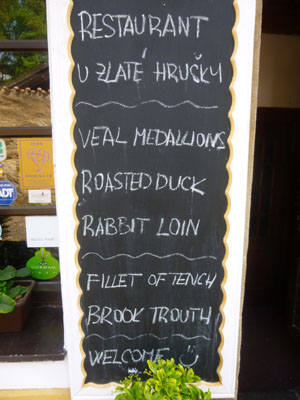 |
I was impressed with the variety of offerings on the second sign. You've got veal, duck, rabbit (who serves rabbit?), and fish. I am pretty sure that the restauranteur meant "trout" rather than "trouth" (as I haven't been able to find "trouth" anywhere). I was able, however, to find out that "tench" is actually a fish in the minnow family that is found in rivers and lakes throughout central Europe. I hope they are bigger than minnows, though.
At the top of the hill, after our pleasant walk through this typical hillside neighborhood, we arrived at the Loreto.
The Loreto
The Prague Loreto is a pilgrimage destination; it consists of a cloister, the church of the Lord’s Birth, the Santa Casa and a clock tower with a famous chime. Construction started in 1626 and the Holy Hut was blessed on 25 March 1631. The architect was the Italian Giovanni Orsi, and the project was financed by Katerina Benigna, a noblewoman of the Lobkowicz family. Fifty years later the place of pilgrimage was surrounded by cloisters, to which an upper storey was added after 1740 by Kilián Ignác Dientzenhofer. The baroque facade was added at the beginning of the 18th century.
Outside the Loreto
|
The Prague Loreto is an artistic and historical monument, as well as a Baroque pilgrimage site the renown of which in the city can perhaps be compared only with that of the wonder-working statue of the Infant of Prague. Construction of the Prague Loreto Santa Casa began in 1626, at the instigation of Baroness Benigna Katharina von Lobkowitz. The Loreto arose gradually over the course of the 17th and 18th centuries; the interiors were partly renovated in the 19th century; and in the 1950s and 1960s, a new treasury was built, accessible to the public.
The pilgrimage site is conceived as a self-contained complex of buildings around a central Santa Casa, with an oblong, two-storey arcade courtyard (unlike the Italian Loreto, where the Casa is inside the pilgrimage church). The present-day Church of the Nativity of Our Lord (on the longitudinal axis) and two of the chapels (in the middle of the northern and southern wings) were only shallow alcoves with altars in the original design from the 1660s. As the renown of the Loreto grew, the number of visitors increased and it was necessary to enlarge the liturgical spaces of the pilgrimage site. Thus, gradually (by the end of the 17th century) the larger oblong chapels were built in the corners of the courtyard; subsequently, both chapels on the transversal axis were enlarged and the Chapel of the Nativity of Our Lord reconstructed in several phases into a more spacious church.
|
|
The front of the Loreto was, as you have seen so far, impressive, and it was hard not to keep photographing it from every conceivable angle. With the sculptures, the symmetry, and the bell tower, it was quite beautiful.
The carillon, housed of course in the bell tower, plays every hour to encourage visitors to pray. At the time it was put into operation at the end of the 17th century it was a true rarity in Bohemia.
It was given to the Loreto by the rich merchant from the Lesser Town, Eberhard von Glauchau. The author of all thirty signed bells (one was damaged in the 18th century and replaced) was the Amsterdam town bell-founder Claudy Fremy, who made them between 1683-91. The consecration of the bells in the Loreto in 1695 before they were set in the clock-tower was a grand occasion. Every bell had its sponsor from among the ranks of the high aristocracy; Emperor Leopold I assumed patronage of the first of them.
Over the next few months the Prague clockmaker Peter Neumann arranged the carillon and attached it to the clock mechanism of the tower in the facade; he created a mechanism on the principle of a metal cylinder with pegs for setting various melodies. The carillon can also be controlled by means of a two-and-a-half octave keyboard on which various compositions are played (usually on church holidays). This carillon is a very complex mechanism, similar to the carillons in Amsterdam, Delft, Brugge and Berlin. The tuning of the bells is relatively pure and thus the carillon can be used as a distinctive musical instrument. The Loreto bells rang over the Prague roofs for the first time in 1695.
The Prague Loreto Carillon is unique especially for its authenticity; it is one of the last surviving Baroque musical instruments in Europe the mechanism of which was not modernized in any way. Our little guidebook said that the sound of the music heard inside the Loreto is a remarkably different from the experience of listening to it while standing on the square; the carillon was designed to be listened to by the Loreto pilgrims gathered in the courtyard beside the Santa Casa. Sadly, we were not able to experience this difference; the carillon was in the midst of being cleaned and adjusted on the day we were there (and actually for quite a few days before and after).
Before we go inside the Loreto, I have a few additional pictures of the outside of the complex that I want to include in this album:
|
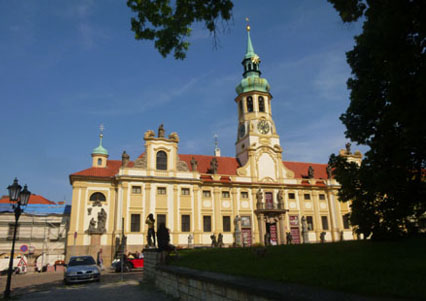
Fred and I headed through the main entrance and paid the $10 entrance fee. We were told that there was an additional fee if you wanted to take pictures; the fee was to be paid by each person taking pictures. To save a bit of money, I bought a photography permission decal, put Fred's camera around my neck, and for the rest of the afternoon not only took my pictures but the ones Fred asked me to take with his camera.
The Arcades and Chapels
|
In the interior courtyard, there were two really neat fountains that we stopped to see, and one of the central foci of the Loreto- the Santa Casa. In the middle of the east side of the rectangular building is the Church of the Nativity of Our Lord, the other major feature of the Loreto.
Finally, on the upstairs level are various rooms where there are various exhibits devoted to aspects of the Loreto itself, or displays of monstrances and other religious objects.
The first group of pictures that we will take a look at are those that we took in the various chapels arrayed around the three sides of the ground floor of the Loreto.
|
|
The chapels that are arrayed around the courtyard, with entrances off the arcade walkway, include the Chapel of St. Anne (3), the Chapel of St. Francis Seraphinus (4), the Chapel of the Holy Family (5), the Chapel of the Holy Rood (9), the Chapel of St. Antony of Padua (10), and the Chapel of Our Lady of Sorrows (11).
Most of the chapels were open and we could have a look inside. Each seemed to be perhaps ten feet by twelve feet, and each contained an altar (or perhaps that is not the right word). Most also contained other furnishings and almost all of them also had paintings or frescoes. And each of them had ceiling frescoes or paintings.
Here are pictures of the altars in three of the chapels:
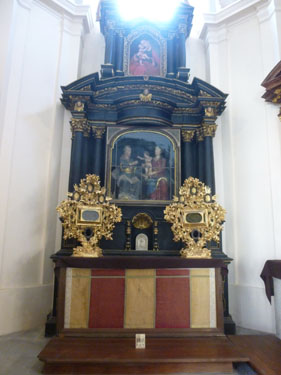 |
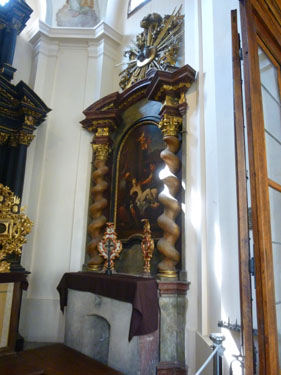 |
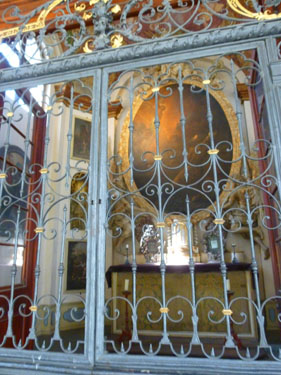 |
And here are some of the beautifully-frescoed ceilings in some of these chapels:
|
|
|
|
The Santa Casa
|
On the northern wall are "The Nativity of Our Lady" and "The Betrothal of Our Lady". On the western wall are "The Annunciation", "The Virgin Mary Visiting St. Elizabeth" and "The Holy Family at the Registry in Bethlehem". On the southern wall are "The Nativity of Our Lord", "The Adoration of the Shepherds" and "The Adoration of the Magi".
The eastern wall (which was so close to the Church that we were unable to get photographs- a situation you can see in that last picture) depicts "The Death of Our Lady" and "The Translation of the Holy House from Nazareth to Europe".
The relief bays are separated by niches with other sculptures. In the lower storey, these are of the Old Testament prophets, and in the upper storey they are of the pagan Sibyls (those who foretold the birth of Jesus and the Virgin Mary).
|
|
|
Here are two more good pictures that we took of the outside of the house- the first looking towards the northern wall and the second looking at the southern wall with the church behind:
 (Click on Thumbnails to View) |
The interior of the casa (which we were never able to photograph adequately as flash photography was not allowed) was divided into two parts in a traditional manner by a silver (partly wooden) grille partition, with an altar in front. In the smaller space the wonder-working statue of Our Lady of Loreto is situated; made of linden wood, it copies the no-longer extant original that was made of cedar wood. The sculpture rests in a rich, wrought silver frame from 1671, with the coat-of-arms of the donor, Countess Elizabeth Apollonia Kolowrat. Most of the objects in the Santa Casa (the reliquaries, obelisks, candlesticks, lamps and liturgical instruments) date from the 17th century.
The Courtyard Fountains
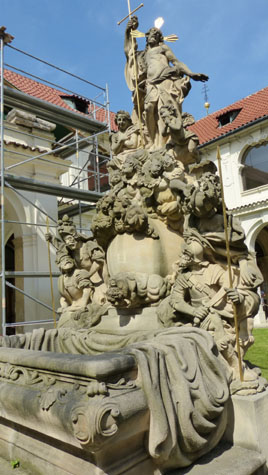 |
(Picture at left) This fountain is a sculptural group depicting the Resurrection.
Both of these fountains were constructed between 1738 and 1740. They were made in the workshop of J. M. Brüderle. He died in 1740 just shortly before the sculptures were complete; after his death, R. Prachner took over the commission. These are not they original fountains; they are copies of the originals that are now deposited in the stone collection in the National Museum at Wenceslas Square.
(Picture at right)
|
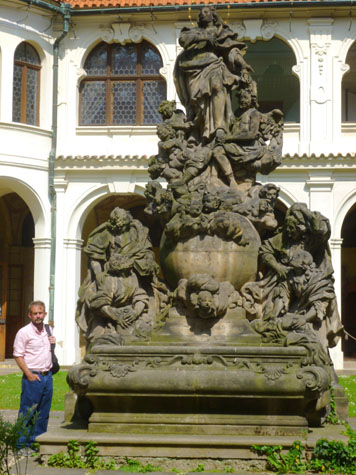 |
The Church of the Nativity of Our Lord
|
The two side altars of Saint Felicissimus and Saint Marcia, with their large reliquary display cases, are located in the chancel.
The side altars in the nave have superb Rococo paintings of St Apollonia and St Agatha, by Anton Kern (1709-1747), supplemented at the sides by equally impressive sculptural pairs of cherubs by Richard Prachner.
The original organ by the master L. Spiegel, provided by the Countess Eleonore Caroline von Lobkowitz in 1718, was replaced somewhere around 1735 by a new instrument by the masters F. Katzer and K. Weltzer from Králíky. The organ is located in a loft at the rear of the nave. (The church is situated on an east-west axis, with the altar at the east end and the organ loft at the west end, adjacent to the Santa Casa in the convent courtyard.)
|
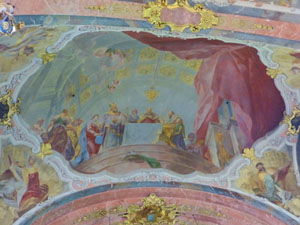 |
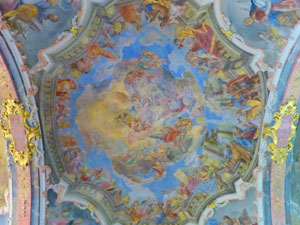 |
Just at the back of the nave there was a fascinating discovery in 2011. The entrance to a hitherto unknown crypt was discovered literally under the marble slabs of the floor. In the crypt were found unique Baroque mural paintings depicting motifs of Death and Resurrection, allegories of Time, and symbols of the fragility and transience of human existence.
These frescoes of exceptional quality were created in 1664 and were commissioned by the then patroness of Loreto, Countess Elisabeth Apollonia of Kolowrat. The main scene depicting the Raising of Lazarus was based on the famous etching by Rembrandt. The Loreto fresco is remarkable because it is a very early reaction to Rembrandt's work- created when the artist was still alive. (Sadly, the crypt is not open to the public.)
|
|
Of course, popes and priests, ministers and deacons, and the high and low of almost every religion will be quick to point out that pay for play is certainly NOT the operative modus operandi of their religion; the deity is just as apt to listen to the entreaties of the poor in their hovels as it is to the rich in their opulent cathedrals. This is what they will say, but it is certainly belied by what they do. Why, I have to continually ask, is it thought necessary or even desirable that so much treasure and effort be spent to adorn these churches and cathedrals? Why is it not thought better to more closely follow the consistent message of the deity itself- that "it is easier for a camel to go through the eye of a needle than for a rich man to enter the kingdom of God"?
Having said all that, I'll climb down off my soapbox and just show you some more of the pictures we took here in the nave:
 (Click on Thumbnails to View) |
The Exibitions
|
We saw a few paintings, although the upstairs exhibition was far from an art gallery. You can see Fred with a portrait of one of the patrons of the Loreto here and a rather odd painting that I don't have an explanation for here.
|
This picture, shown at left, was done in Bohemia in 1667 (although the separate inscription band is of a later date, around 1702). The coat of arms of the Chodau family is in the bottom left corner.
The sign beside the painting said:
| "The portrait of Ludmila Eve Frances originally decorated- limilarly to the previous two- the rooms of the Baroque treasury. It is dated 1667, the year the Countess, at the age of 51, had been married for the third time. It is assumed the portrait shows her in her wedding gown. The dress is lavishly decorated, not only with lace and pearls, but also with large sewn-on appliques adorned with diamonds. It is believed the (sic) those precious stones had been among those decorating the Diamond monstrance, which, thanks to the generous bequest of the Countess, had been created in Vienna between 1696 and 1699 by two court artists, the goldsmith Johann B. Khunischbauer and the jeweller Matthias Stegner, probably after the design of the architect Johan B. Fischer von Erlach." |
Fred and I have been to numerous churches where there were museums or display areas associated with them; sometimes these have been so extensive as to be overwhelming. But I thought that the exhibition space here was just the right size- and the items on display were all interesting.
|
There were two other interesting exhibits to mention. One concerned the evolution of the architectural form of the Loreto over the years, and the other was an exhibit devoted to the main tower and carillon.
|
The exhibits were all interesting, and we enjoyed both looking at them and our entire visit to the Loreto, which had now come to an end. There were some gardens alongside the palace across the plaza, so we thought we would go have a look at them.
The Gardens of the Czernin Palace
The Czernin (also spelled "Cernin") Palace opposite the Loreta is the largest of the baroque palaces of Prague, and has served as the offices of the Czechoslovak and later Czech foreign ministry since the 1930s. It was commissioned by the diplomat Humprecht Jan Cernín z Chudenic, the Habsburg imperial ambassador to Venice and Rome, in the 1660s.
|
In 1666, Humprecht Jan Czernín purchased a part of the debt loaded property of the House of Lobkowicz, including a building plot with gardens located in the centre of Prague. In 1668, he commissioned Francesco Caratti, a Swiss-Italian architect, and assigned him to develop the project of his new palace on the site. The next year, building contractors Gione Decapaoli and Abraham Leuthner started construction. The plasterers Giovanni Maderna and Giovanni Battista Cometa were replaced by Francesco Peri and Antonio Travelli in 1674. The result was one of the Czech Republic's largest and handsomest Baroque palaces.
When we were here, I did not know that the gardens belonged to the Czernin Palace; I did not even know that's what the building across from the Loreto was. It wasn't until I started working on this page that I discovered the identity and history of the building adjacent to these gardens.
|
When I think of a garden, I think of lots of flowering plants, but the gardens here at the Czernin Palace were not that; the area was more like a park than a garden, and was perhaps even more restful and attractive for that distinction.
This was a place for people to stroll and relax, not so much a place for horticulturists to wow visitors with a plethora of beautiful flowering plants. I could easily imagine a garden party being held here, with the nobility and their retinues enjoying an afternoon gathering or an evening under the stars. This lifestyle took money, but Jan Czernin obviously had plenty.
We spent the short amount of time we were here in the Old Garden, although we did wander over into the New Garden so Fred could have a look at the trees and shrubs. But it was nicer wandering around the fountain and pools in the Old Garden.
|
We also took a number of good pictures here in the gardens, and you can see some of them below:
|
I also tried my had at a few panoramic shots within the camera, and a couple of them turned out well enough to include here.


Our Last Evening in Prague
We returned to the Ibis to relax for a while and then Jeffie came by to collect us to head off for some supper at a local place she had been before- the Two Cats Restaurant. Getting there was neither easy nor direct; Jeffie had only a general notion of where the restaurant was, and we went up one street and down another, finally ending up near Wenceslas Square where we finally found the restaurant (quite by accident, actually). Along the way there were interesting sights, and we photographed a good many of them.
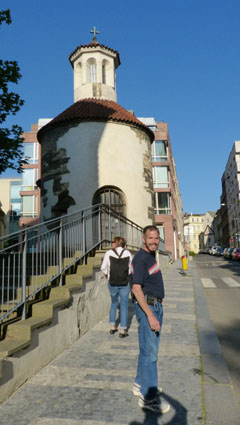 St. Longin's Rotunda- a romanesque rotunda, part of a parish church founded in the 12th century for a village that predates Prague. |
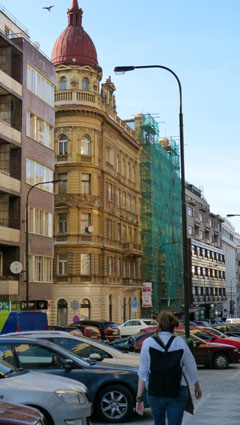 An old office building repurposed as apartments |
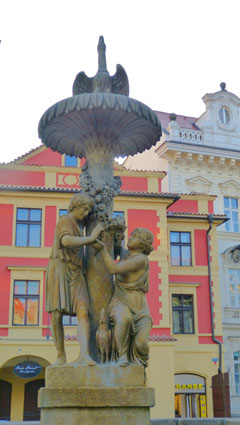 Wimmer's Fountain, an outdoor fountain and sculpture in Old Town |
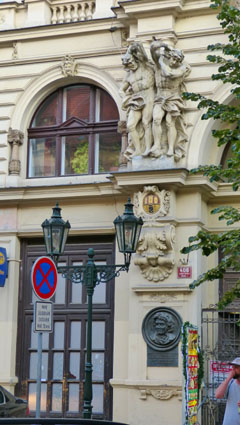 Few buildings in Prague aren't ornamented with sculptures or interesting architectural details. |
|
The church of St. Stephen was founded in 1348 together with New Town by Charles IV (1316 – 1378), the King of Bohemia and also the Holy Roman Emperor. New Town was a quarter outside the existing city walls, the youngest and largest of the five independent towns that today comprise the historic center of modern Prague. An avid collector and admirer of relics, he obtained the remains of St. Stephen in Rome and donated them to the church.
The St. Stephen Church served as a parish church for the upper part of New Town (in the lower part of New Town this function was fulfilled by the Church of Saints Henry and Kunnigunde). At first the church was managed by the order of Knights of the Cross with the Red Star, just when Charles IV took most of the land for the founding of New Town. It took half a century (1351-1401) to build the church; completion of the western tower is dated to the year 1401, when the whole church must have already been built. The church also had a large lot, filling most of the block between four present-day streets. There was a parish garden and a large cemetery. During the plague epidemic in 1502, more than fifteen thousand people were buried there.
The church comprised several buildings- a rectory, a school, a wooden belfry (which was rebuilt in stone in the early 17th century), the Chapel of All Saints, Jerusalem chapel,and the rotunda. In 1686, the Cornel Chapel was added in the south wall of the nave, and then the Branber Chapel was built on the north wall of the sacristy; the latter chapel opened in 1739.
In 1866 a Neo-Gothic hall was built in the north part of the nave. A known restorer of that time, Josef Mocker, redesigned and restored the church in a puristic style between 1874 and 1879. He was responsible for restoring many Bohemian castles and ancient buildings in Prague. His work in a puristic Gothic Revival style aroused much controversy, but also contributed to many important landmarks of Prague. Here Josef Mocker designed a new tracery in the presbytery, a new window in the nave, and also a frontage in the aisle. Nowadays, the church is managed by Roman Catholic parish of St. Stephen and is owned by the Archdiocese of Prague.
|
The church was built in the middle of the area of Gall Town, and was built in Romanesque style. One century later the church was rebuilt into a three-aisled basilica. Some of the original Gothic elements have survived. The church went through a very important reconstruction at the end of the 17th century; this reconstruction restyled into a thoroughly Baroque structure. A gorgeous front face has survived from this period; it was constructed according to the plans and designs created by Jan Santini Aichel and Pavel Ignác Bayer.
It is curious that the church of St. Gall has several chapels. One of them was built in 1673 and has exceptional stucco decorations. In this chapel is the grave of a remarkable painter of the Baroque period- Karel Škréta. Another chapel is the imperial chapel from 1730. There is also the chapel of St. Wenceslas with the group of statues "Calvary and the Four Evangelists", created by Brokoff in 1726.
The abbot Svatý Havel (Saint Gall, "Havel" being the Czech translation of his original name Gallon) was born in 545 and died in 640. He was born in Ireland where he later entered a monastery. According to tradition, he then traveled as far as Switzerland, dispensing charity. He also founded the famous monastery Sankt Gallen. This church is, of course, named for him.
From the street rise the gorgeous church towers that are surely the main external feature of the church. Each tower is more than 150 feet high. These towers can also be climbed inside, but we didn't have time to do that this evening. Perhaps on a return visit we can do so; the views are supposed to be quite impressive, as most of Old Town is so close.
|
In the walking we did this evening, we were able to appreciate, yet again, how pretty the city of Prague actually is. Nondescript streets have an air of opulence, and just about every building and church had architectural features worth admiring:
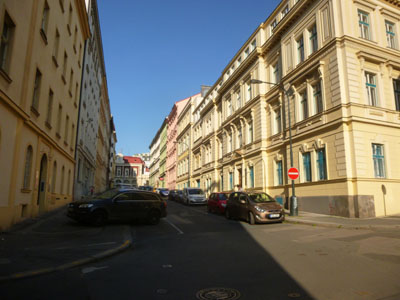 |
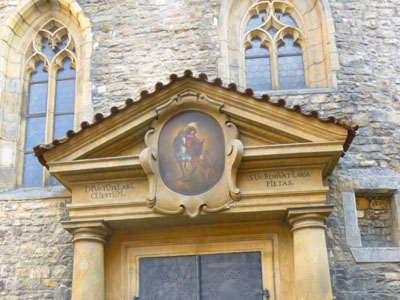 |
After a number of wrong turns, but a very pleasant evening walk through the streets of the Old Town we finally found our destination- the Two Cats Restaurant. Save for the two cats painted on the building outside, I'm not sure why it got that name, but the food was certainly good.
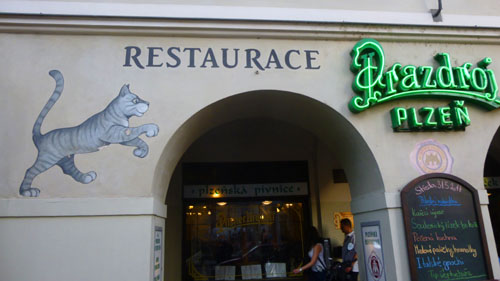 |
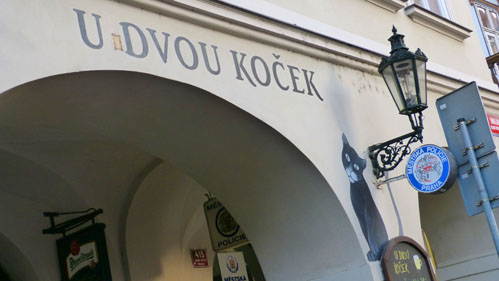 |
After dinner, we found ourselves back near Captain Candy where I laid in a supply of the extremely tart candies I'd purchased some of a few days earlier. We took the Metro back to the station near the hotel. There, we bid goodbye to Jeffie- but not for long, as she would be joining us the day after tomorrow in Istanbul. But that's another trip altogether. Today brought our sightseeing in Prague to a close, so we retired ahead of an early morning departure for the airport.
You can use the links below to continue to another photo album page.
 |
May 30, 2017: The Charles Bridge; Mala Strana; Old Town |
 |
Return to the Index for Our Visit to Prague |